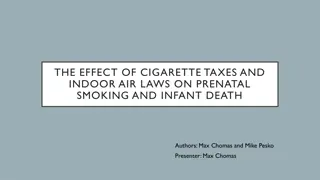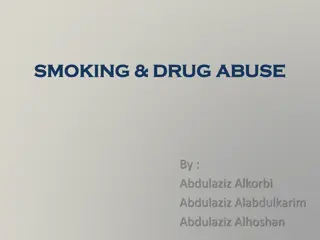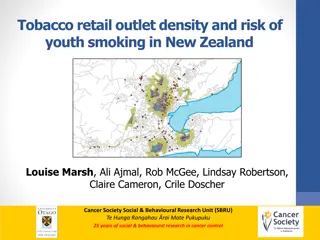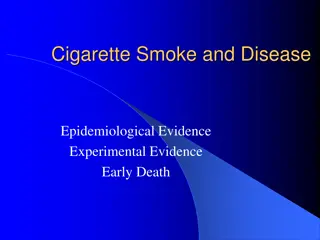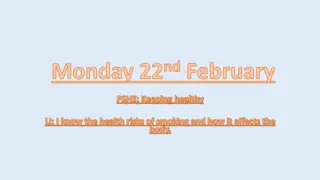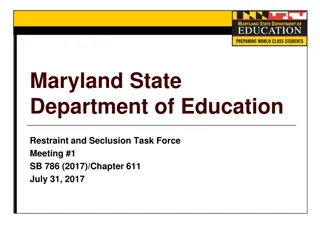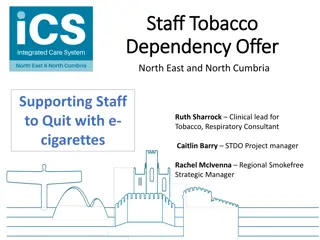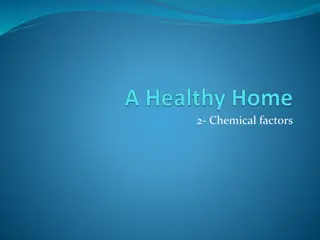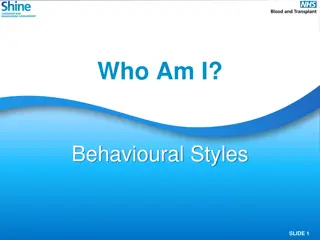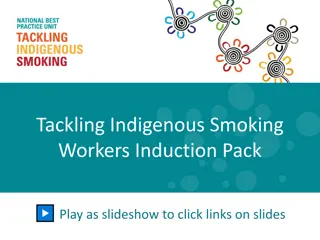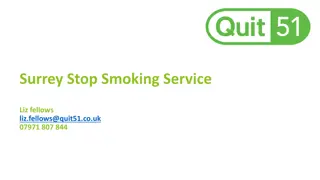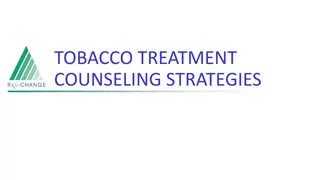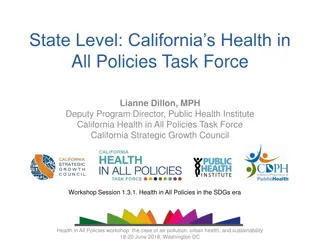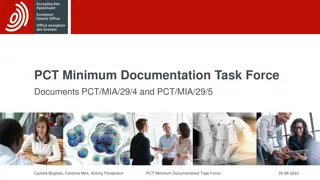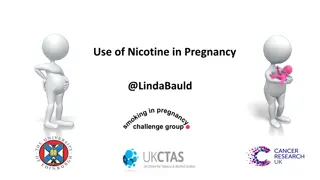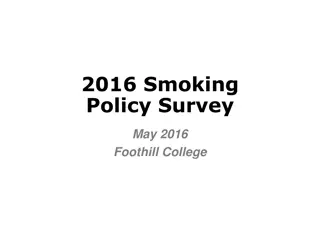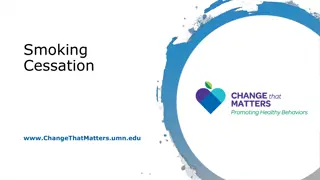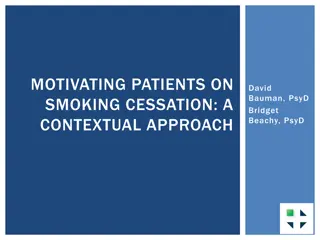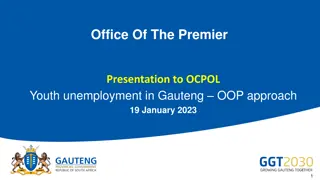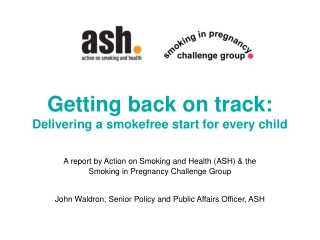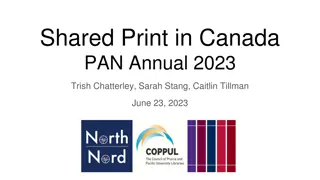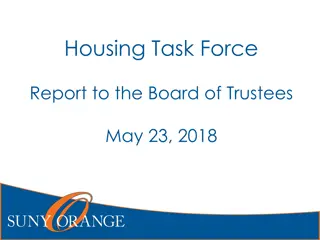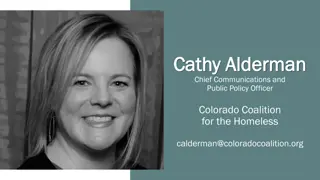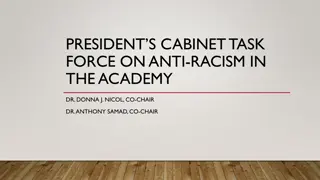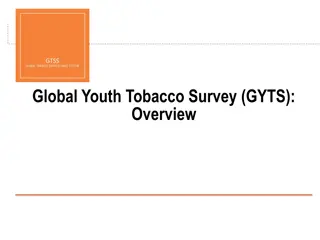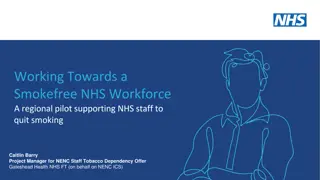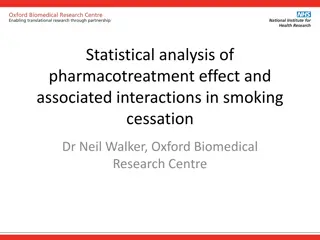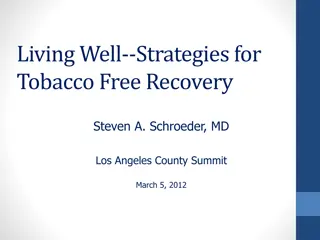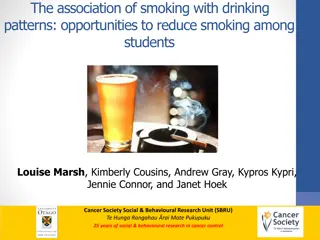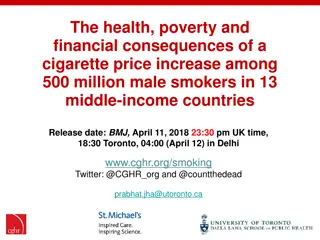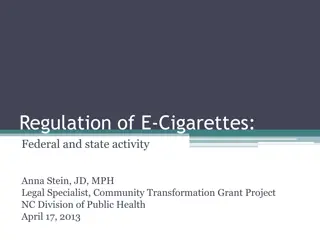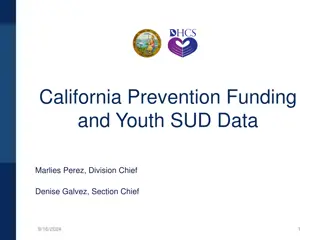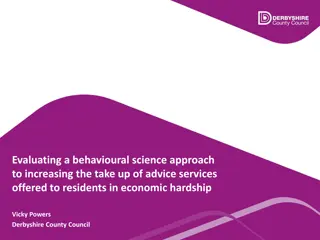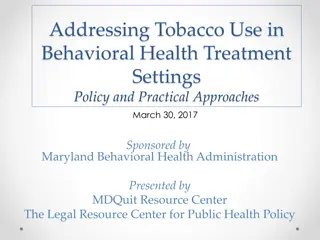Canadian Task Force Recommendations on Behavioural Interventions for Cigarette Smoking Prevention in Youth
The Canadian Task Force on Preventive Health Care (CTFPHC) provides recommendations on behavioural interventions for preventing and treating cigarette smoking in school-aged children and youth. The guidelines focus on evidence-based strategies to address tobacco smoking in adolescents, emphasizing prevention measures and effective treatment approaches. The presentation covers background information, key findings, implementation strategies, and concludes with a Q&A session.
Uploaded on Sep 12, 2024 | 0 Views
Download Presentation

Please find below an Image/Link to download the presentation.
The content on the website is provided AS IS for your information and personal use only. It may not be sold, licensed, or shared on other websites without obtaining consent from the author. Download presentation by click this link. If you encounter any issues during the download, it is possible that the publisher has removed the file from their server.
E N D
Presentation Transcript
Recommendations on Behavioural Interventions for Prevention and Treatment of Cigarette Smoking in School-aged Children and Youth 2017 Canadian Task Force on Preventive Health Care (CTFPHC) Putting Prevention into Practice Canadian Task Force on Preventive Health Care Groupe d tude canadien sur les soins de sant pr ventifs CMAJ Online Release: February 27, 2017
WebEx How can I participate today? Audio option- you can ask questions and participate directly in the discussion by unmuting your audio. Mute or unmute your audio on your phone or by clicking on the microphone next to your name in the participant list. 2
WebEx How can I participate today? Chat Box option- you can also type your questions or comments into the chat box. 1. You can send comments to everyone You can send comments directly to the KT moderator (to read to the group) or to individual participants 2. 3
Use of slide deck These slides are made available publicly following the guideline s release as an educational support to assist with the dissemination, uptake, and implementation of the guidelines in primary care practice. Some or all of the slides in this slide deck may be used in educational contexts. 4
Overview of Presentation Background on Tobacco Smoking in Children and Adolescents Methods of the CTFPHC Recommendations and Key Findings Implementation of Recommendations Conclusions Questions and Answers 5
CTFPHC Working Group Members Task Force Members: Brett Thombs (Chair) Kevin Pottie Patricia Parkin Marcello Tonelli Evidence Review and Synthesis Centre: Leslea Peirson* Muhammad Usman Ali* Donna Fitzpatrick-Lewis* Meghan Kenny* Parminder Raina* Sharon Peck-Reid* Maureen Rice* Diana Sherifali* Rachel Warren * Public Health Agency: Alejandra Jaramillo Garcia* Dana Reid* Kate Morisette* *non-voting member 6
Tobacco Smoking Prevention and Treatment in Children and Adolescents BACKGROUND 7
Background Tobacco kills up to half of its users globally The global tobacco epidemic is one of the largest public health threats Tobacco users who die prematurely: Deprive their families of income Raise the cost of health care Hinder economic development A person who starts smoking as a child or youth is less likely to quit later in life than someone who starts later Annual cost to Canadian society was estimated at $17 billion in 2002 Among Canadian youth, 18% have tried cigarettes Increasing from 3% of 6th graders up to 36% of 12th graders 8
Guideline Scope This guideline presents evidence-based recommendations for the prevention and treatment of tobacco smoking in children and youth (5-18 years) The Canadian Task Force on Preventive Health Care (CTFPHC) has not made previous recommendations on this topic 9
Tobacco Smoking Prevention and Treatment in Children and Adolescents METHODS 10
Methods of the CTFPHC Independent panel of: Clinicians and methodologists Expertise in prevention, primary care, literature synthesis, and critical appraisal Application of evidence to practice and policy Tobacco Working Group 4 CTFPHC members Establish research questions and analytical framework 11
Methods of the CTFPHC Evidence Review and Synthesis Centre (ERSC) Undertakes a systematic review of the literature based on the analytical framework Prepares a systematic review of the evidence with GRADE tables Participates in working group and task force meetings Obtains expert opinions 12
CTFPHC Review Process Internal review process involving guideline working group, CTFPHC, scientific officers, and ERSC staff External review process involving key stakeholders Generalist and disease-specific stakeholders Federal and Provincial/Territorial stakeholders CMAJ undertakes an independent peer review process to review guidelines 13
Research Questions The systematic review for tobacco prevention and treatment included: (2) key research questions on prevention with (2) sub questions (3) key questions on treatment with (2) sub questions (2) contextual questions Based on the search done for the 2012 United States Preventive Services Task Force (USPSTF) review on the same topic For more detailed information, please access the systematic review www.canadiantaskforce.ca 14
Analytical Framework: Prevention & Treatment Prevention KQ2 school-aged children and youth (5-18 years) who have never smoked tobacco or are not currently smoking tobacco interventions to prevent tobacco smoking incidence of tobacco smoking prevalence of adult tobacco smoking KQ1 Treatment KQ4 school-aged children and youth (5-18 years) who currently smoke tobacco interventions to treat tobacco smoking incidence of stopping tobacco smoking prevalence of adult tobacco smoking KQ3 KQ5 Harms of treatment 15
Research Questions Prevention KQ1 Are behaviourally-based interventions that are designed to prevent tobacco smoking effective in preventing children/youth from trying or taking up tobacco smoking? KQ2 Are behaviourally-based interventions designed to prevent tobacco smoking in children/youth effective in reducing tobacco smoking during adulthood? Treatment KQ3 Are behaviourally-based and non-pharmacological alternative and complementary interventions effective in achieving smoking cessation? KQ4 Are behaviourally-based and non-pharmacological alternative and complementary interventions effective in reducing future tobacco smoking in adulthood? KQ5 What if any, adverse effects are associated with behaviourally-based and non-pharmacological alternative and complementary interventions designed to help children/youth stop ongoing tobacco smoking? 16
Eligible Study Types Population: School-aged children (5-12 years) and adolescents (13-18 years) Product: Combustible tobacco products (e.g. cigarettes) (excludes: smokeless tobacco products or e-cigarettes) Language: English, French (French studies published after 2012) KQ1,KQ2: Prevention KQ3-KQ5: Treatment Randomized controlled trials (RCTs) that have a minimum of 30 participants per arm/group of interest for baseline measures Benefits: RCTs that have a minimum of 30 participants per arm/group of interest for baseline measures Harms: RCT or comparative observational designs and there are no conditions regarding sample size Study Type Benefits: incidence of tobacco smoking; prevalence of adult tobacco smoking Benefits: incidence of stopping tobacco smoking; prevalence of adult tobacco smoking Harms: adverse effects of interventions (e.g., anxiety, pain, discomfort, infection) Outcomes 17
How Does the CTFPHC Grade Evidence? The GRADE System: Grading of Recommendations, Assessment, Development & Evaluation 1. Quality of Evidence 2. Strength of Recommendation Confidence that the available evidence correctly reflects the theoretical true effect Quality of supporting evidence Desirable and undesirable effects Values and preferences Resource use High, Moderate, Low, Very Low Strong, Weak 18
Interpretation of Recommendations Implications Strong Recommendation Weak Recommendations For patients Most individuals would want the recommended course of action; only a small proportion would not. The majority of individuals in this situation would want the suggested course of action but many would not. For clinicians Most individuals should receive the intervention. Recognize that different choices will be appropriate for individual patients; Clinicians must help patients make management decisions consistent with values and preferences. Policy making will require substantial debate and involvement of various stakeholders. For policy makers The recommendation can be adapted as policy in most situations. 19
Tobacco Smoking Prevention and Treatment in Children and Adolescents RECOMMENDATIONS & KEY FINDINGS 20
Tobacco Smoking in Children and Adolescents: Prevention Recommendation These guidelines provide recommendations for practitioners on preventive health screening in a primary care setting We recommend asking children and youth (5-18 years) or their parents about tobacco use by the child or youth and offering brief information and advice as appropriate during primary care visits to prevent initiation of tobacco smoking Weak recommendation, low quality evidence Applies to children and youth (5-18 years) who: Do not currently smoke tobacco (includes never or former smokers) Do not have cognitive deficits Do not have mental or physical health issues Do not have a history of alcohol or drug abuse 21
Tobacco Smoking in Children and Adolescents: Treatment Recommendation These guidelines provide recommendations for practitioners on preventive health screening in a primary care setting We recommend asking children and youth (5-18 years) or their parents about tobacco use by the child or youth and offering information and brief advice, as appropriate, during primary care visits to treat tobacco smoking among children and youth who have smoked in the last 30 days Weak recommendation, low quality evidence Applies to children and youth (5-18 years) who: Have smoked tobacco within the past 30 days Do not have cognitive deficits Do not have mental or physical health issues Do not have a history of alcohol or drug use 22
Rationale for Recommendations Recommendations are in favour of low-intensity, behavioural preventive and treatment interventions for children/youth, because of the: Potentially moderate reduction in smoking initiation Modest increase in the likelihood that youth will stop smoking Similarsize effect of low and high intensity interventions High likelihood that harms of preventive or treatment interventions are minimal Fact that stakeholders find interventions important and acceptable The recommendations on both prevention and cessation are based on limited evidence, and, thus, are weakbecause of low certainty that the: - Evidence reflects the true effect of behavioural interventions, for either prevention or treatment of smoking - Lack of evidence that any benefit, if present, would be sustained or have longer-term health benefits 23
Comparison: CTFPHC guideline vs. other recommendations Organization Recommendation Prevention Treatment Canadian Task Force on Preventive Health Care (current) Ask about tobacco use and offer brief information and advice at appropriate primary care visits to prevent tobacco smoking among children and youth (5-18 years). Ask about tobacco use and offer information and brief advice (i.e. low intensity behavioral interventions) at appropriate primary care visits to treat tobacco smoking among children and youth (5-18 years) who have smoked within the last 30 days. Offer counseling for smoking cessation. Stay aware of research on pharmaceutical cessation interventions for teens and adults and prescribe effective medications as indicated, in combination with counselling. Recommendations were not made for or against treatment. Ask children, youth and families about tobacco use and exposure and provide age-appropriate information and counselling to prevent initiation as part of routine health care. Canadian Paediatric Society (2016) US Preventive Services Task Force (2013) Provide interventions, including education or brief counselling, to prevent initiation of tobacco use in school-aged children and adolescents. 24
Comparison: CTFPHC guideline vs. other recommendations Organization Recommendation Prevention Obtain information about tobacco use on a regular basis. Provide counselling that supports abstinence from tobacco to children and adolescents. Treatment Provide counselling that supports tobacco cessation among children and adolescents who use tobacco. Canadian Action Network for the Advancement, Dissemination and Adoption of Practice-informed Tobacco Treatment (CAN-ADAPTT) (2011) American Academy of Pediatrics (2009) Screen for tobacco use and tobacco smoke exposure, counsel children and parents about the harms of tobacco at most visits. No recommendation Provide advice to tobacco users about cessation strategies and resources at most visits. Give brief advice to stop smoking to all people who smoke; provide evidence-based cessation support for people who express a desire to stop smoking; recommend smoking cessation treatments of proven effectiveness to people interested in stopping smoking. Recommend ongoing cessation services to all tobacco users. New Zealand Ministry of Health (2007) Institute for Clinical Systems Improvement (US) (2013) Establish tobacco use status for all patients and reassess at every opportunity. Reinforce non-users to continue avoiding tobacco products. 25
Knowledge Gaps Lack of high-quality RCTs that examine the short and long-term benefits of behavioural prevention and treatment interventions More research is needed to identify the characteristics of the most effective interventions, including factors such as the: Type of advice provided Duration of the intervention Type of provider Contact time needed No conclusive evidence in either adults or youth on the potential harmful effects of e-cigarettes or whether they can be used in smoking cessation Further research is needed to assess the benefits and harms of interventions in at risk populations 26
Tobacco Smoking Prevention and Treatment in Children and Adolescents IMPLEMENTATION OF RECOMMENDATIONS 27
Considerations for Implementation Primary care practitioners implement procedures to assess smoking risk and/or status in a child or youth If practitioner determines likely need for a prevention or cessation intervention Primary care practitioner should ask if the child/youth and/or parent would consider having a brief conversation that may help the child/youth: - Prevent the uptake of smoking - Stop smoking Most children and youth and their parents/caregivers would want the child or youth to receive the recommended course of action - - Many would not (implication of a weak recommendation) For those who consent, primary care practitioners should offer them brief information and advice at appropriate primary care visits 28
Considerations for Implementation Primary care practitioners who may deliver the intervention include: - Family physicians, nurses, or other appropriate members of the health care team Brief information and advice may include verbal communication of up to five minutes to discuss patient attitudes and beliefs, risks of smoking, and/or strategies for dealing with the influence of peers Sharing of printed or electronic material (brochures, newsletters and interactive computer programs) could be considered Appropriate primary care visits include scheduled health supervision visits, visits for immunizations or medication renewal, episodic care or acute illness, and other visits 29
Values and Preferences CTFPHC did not conduct a full systematic review of the evidence on parental preferences or values Neither youth nor clinician preferences were examined due to resource limitations The CTFPHC recruited parents of school-aged children and youth (smokers and non-smokers) for a focus group (n=10) and subsequent survey (n=13) Parents agreed it is important to offer prevention and treatment interventions, but would want to be informed about the components of offered interventions Some parents questioned primary care settings as the best place for behavioural interventions Better data is needed on the values and preferences of children and youth 30
Knowledge Translation Tools The CTFPHC creates KT tools to support the implementation of guidelines into clinical practice After the public release, these tools will be freely available for download in both French and English on the CTFPHC website: www.canadiantaskforce.ca 31
Tobacco Smoking Prevention and Treatment in Children and Adolescents CONCLUSIONS 32
Conclusions: Key Points The evidence suggests that low-intensity behavioural interventions based on providing information and advice aimed at prevention and treatment of smoking among children and youth may be effective The CTFPHC therefore recommends that primary care practitioners consider offering them to children and youth aged 5 to 18 years 33
More Information For more information on the details of this guideline please see: Canadian Task Force for Preventive Health Care website: http://canadiantaskforce.ca 34
Questions & Answers Thank you 35


